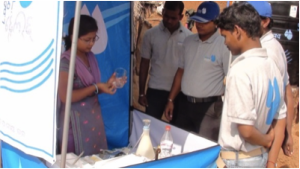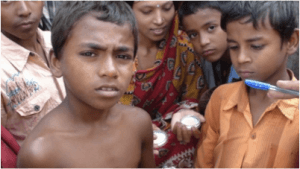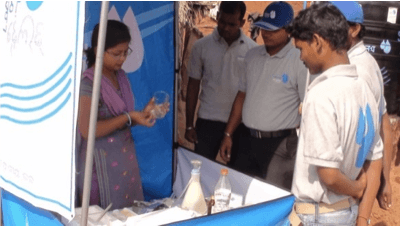
Spring Health, our rapidly scalable safe drinking water company designed to go global, has now started its commercial rollout in India by recruiting and training 90 new full-time staff, and expanding from 35 villages to 105 villages in three months.
As the months go by, we have learned more and more about the fundamental importance of getting the marketing mix right. We’ve bundled all the most successful tactics into an approach we call “blitz marketing.”
Blitz marketing
We have improved our blitz marketing strategy to the point that we now can increase sales in village partner shops to 1000 liters of water a day within two months of opening — a level at which the company begins to turn a profit. In fact, in one village sales increased from 500 liters a day to 2500 liters a day after only three days of marketing.
We now apply four blitz marketing techniques simultaneously:
- The first is a kiosk opening ceremony with entertainment, and the second is a play performed twice in each village by a professional theatre group.
- The third is festive door-to-door sales by 10-member teams, creating quite a buzz when accompanied by an auto rickshaw with speakers playing music and providing information about water and health.
- Finally, we carry out e coli tests on samples of the water people actually drink. There seems to be nothing more motivating than when families see ugly colonies of bacteria growing out of the water their families are drinking.
- At the end of the marketing blitz, the 100-person marketing blitz team hands over the block of 50 villages to a permanent operations team of three to four full-time members, and moves on to the next 50-village block.
Our village operations include a three-member specialty team that screens villages, consults village elders to identify the best shopkeepers, and signs an agreement with the selected shop partner. Then a four-member build team hires local artisans to build the water tank and connect pipes and electricity to each shop. These two teams recruit and build 50 village systems in one month.

The total cost of conducting the marketing blitz is about $330 per village. Adding net capital equipment investment costs of $200 brings the company’s initial investment in capital expenditures (CAPEX) and marketing to approximately $530. Gross income to the company from each village kiosk is approximately $1,350 per year. Assuming 50% in operating expenses, this leaves about $675, sufficient to cover initial CAPEX and marketing costs within one year.
Last-mile distribution
One of the most exciting things about the operating system we have developed is that it represents a last-mile distribution system to people in small villages that is actually profitable. Each staff member visiting a village carries only 10 kilos of water purifier by motorcycle each day to six villages, leaving some 80 kilos of unutilized cargo space for a whole range of other transformative products for which the last-mile transport costs are close to zero. Within three years, we expect to be in a position to provide last-mile distribution of a whole range of aspirationally branded products to 30,000 village shops while making a healthy profit operating purely as a commercial business without subsidy. Within three years we will deliver safe drinking water in 10,000 villages, and within ten years we plan to deliver safe drinking water to 100 million $2-a-day customers.
For more about Spring Health India, check out this excellent, in-depth Indian TV update featuring an interview with my Indian partner, Jacob Mathew


One thing we learned in Central America, if you do water quality testing on existing drinking water sources, use a blended sample from various local wells or supplies. If you test one specific source and it is dirty, it can be a source of shame for the owner of that source, often the village elder or headman. Who then can be a negative influence against your new source. Don’t make unneeded enemies.
Thanks Larry,
We are testing the actual drinking water that people in the villages are using in their home and they are strongly motivated to learn if their drinking water is safe or not. It’s important both for them and for our marketing efforts to give them an accurate response. Frequently, several families use water from the same open well built by the government and when we test that water from the well it is contaminated, so that all the families using it are drinking unsafe water. Our experience in Orissa is that our brand is associated with telling it like it is if the water is safe we say so, if it is not safe we say so and ultimately I think the advantages of operating this way out weigh the disadvantages but it may well be different for your work and the culture work with in Central America. Thank you for raising this interesting point.
Spring Health are doing a fantastic logical job at minimal cost. Irish co Aqua Nu have developed simple water filtration and safe water storage which when eventually made in India will help also
Look on Youtube at ” Healthy Safe Water saves Lives by Aqua Nu”
The Legionella proof shower head has been launched in the developed world & the floating sprites are available for long term water storage. Other products like the very cheap drinking water bottle will be completed next year. http://Www.aqua-nu.com
Keep up the great work